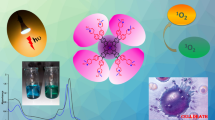Abstract
An important issue that should be taken into consideration when applying the molecules in photodynamic therapy (PDT) of cancer is the occurrence of homo-resonance energy transfer process between them. We have determined the probability of energy transfer for sodium zinc (II)-2,9,16,23-phthalocyanine tetracarboxylate (ZnPc(COONa)4) molecules in aqueous NaOH solution. The homo-quenching effect of the molecule was also measured by calculating the diffusion controlled bimolecular rate constant of k q = 6.5 × 109 M−1s−1, which did not show a significant competition with the rate constant of homo-resonance energy transfer process at the applied concentration of the molecules (6 μM). The Förster radius (R 0) for ZnPc(COONa)4 molecules was calculated to be 42 Å. The availability of these calculations should facilitate the potential application of ZnPc(COONa)4 molecule as an anticancer drug in PDT.







Similar content being viewed by others
References
Lakowicz, J.R.: Principles of Fluorescence Spectroscopy, 2nd edn. Plenum Press, New York (1999)
Kasha, M.: Energy transfer mechanisms and the molecular exciton model for molecular aggregates. Radiat. Res. 20, 55–71 (1963)
Förster, T.: Intermolecular energy migration and fluorescence. Ann. Phys. 2, 55–75 (1948)
Turro, N.J.: Modern Molecular Photochemistry. Benjamin Cummings, Menlo Park, CA (1987)
Lakowicz, J.R.: Principles of Fluorescence Spectroscopy, 1st edn. Plenum Press, New York (1983)
Andrews, D.L., Demidov, A.A.: Resonance Energy Transfer. Wiley, Chichester (1999)
Valeur, B.: Molecular fluorescence: principles and applications. Weinheim, Germany, Wiley-VCH Verlag GmbH (2011)
Wehry, E.L.: Modern Fluorescence Spectroscopy. Plenum Press, New York (1976)
Clegg, R.M.: Förster resonance energy transfer–FRET what it is, why do it, and how it’s done. Lab. Tech. Biochem. Mol. Biol. 33, 1–58 (2009)
Lakowicz, J.R.: Principles of Fluorescent Spectroscopy, 3rd edn. Springer, New York (2006)
Wu, P., Brand, L.: Resonance energy transfer: methods and applications. Anal. Biochem. 218, 1–13 (1994)
Spiker, J.D., Bommer, J.C.: Chlorophyll and related pigments as photosensitizers in biology and medicine. In Chlorophyll, ed. H. Scheer. CRC Press, Florida (1991)
Al-Omari, S., Alghezawi, N., Al-Noaimi, M., Al-Hamarneh, I.F., Marashdeh, M.: Observation on symmetry properties of sodium zinc(II)-2,9,16,23-phthalocyanine tetracarboxylate in water:NaOH solution. J. Fluoresc. 24, 835–9 (2014)
Al-Omari, S.: Toward a molecular understanding of the photosensitizer-copper interaction for tumor destruction. Biophys. Rev. 5, 305–311 (2013)
Al-Omari, S., Ali, A.: Photodynamic activity of pyropheophorbide methyl ester and pyropheophorbide a in dimethylformamide solution. Gen. Physiol. Biophys. 28, 70–77 (2009)
Strickler, S.J., Berg, R.A.: Relationship between absorption intensity and fluorescence lifetime of molecules. J. Chem. Phys. 37, 814–22 (1962)
Hacıvelioğlu, F., Durmus, M., Yesilot, S., Gürek, A.G., Kılıç, A., Ahsen, V.: Synthesis, electronic absorption and fluorescence spectral properties of phenoxycyclotriphosphazene-substituted phthalocyanines. Dyes Pigments 79, 14–23 (2008)
Iglesias, R.S., Segala, M., Nicolau, M., Cabezo, B.: Computational study of the geometry and electronic structure of triazolephthalocyanines. J. Mater. Chem. 12, 1256–1261 (2002)
Kessel, D., Dougherty, T.: Porphyrin photosensitization. Plenum Press, New York (1983)
McKeown, N.B.: Phthalocyanine materials: synthesis, structure and function. Cambridge University Press, Cambridge, UK (1998)
Kadish, K.M., Smith, K.M., Guilard, R.: The Porphyrin Handbook. Academic Press, Boston (1999)
ArgusLab (tm) (2004) Program package. Version 4.0, Planaria Software LLC
Müller, S., Galliardt, H., Schneider, J., Barisas, B.G., Seide, T.: Quantification of Förster resonance energy transfer by monitoring sensitized emission in living plant cells. Front. Plant. Sci. 4, 413–20 (2013)
Stryer, L.: Fluorescence energy transfer as a ruler. Annu. Rev. Biochem. 47, 819–846 (1978)
Al-Omari, S.: Separation of static and dynamic thermodynamic parameters for the interaction between pyropheophorbide methyl ester and copper. J. Porphyrins Phthalocyanines 18, 297–304 (2014)
Al-Omari, S.: Modeling the concentrations and efficiencies for the interacting species of pyropheophorbide methyl ester-copper association. Biophys. Rev. Lett. 8, 73–87 (2013)
Bonacucina, G., Cespi, M., Mencarelli, G., Giorgioni, G., Palmieri, G.F.: Thermosensitive self-assembling block copolymers as drug delivery systems. Polymers 3, 779–811 (2011)
Hink, M.A., Bisseling, T., Visser, A.J.: Imaging protein–protein interactions in living plant cells. Plant Mol. Biol. 50, 871–883 (2002)
Heyduk, T., Heyduk, E.: Molecular beacons for detecting DNA binding proteins. Nat. Biotechnol. 20, 171–6 (2002)
Kavarnos, G.J.: Fundamentals of Photoinduced Electron Transfer. VCH Publishers Inc, USA. (1993)
Simpson, W.T., Peterson, D.L.: Coupling strength for resonance force transfer of electronic energy in Van der Waals solids. J. Chem. Phys. 26, 588–593 (1957)
Al-Omari, S.: Kinetic model for the molecular system of zinc(II)-2,9,16,23-phthalocyanine tetracarboxylate. J. Nonlinear. Optic. Phys. Mat. 24, 1550005 (2015)
Author information
Authors and Affiliations
Corresponding author
Rights and permissions
About this article
Cite this article
Al-Omari, S. Resonance energy transfer and competing processes in donor–acceptor of sodium zinc (II)-2,9,16,23-phthalocyanine tetracarboxylate molecule. J Biol Phys 42, 373–382 (2016). https://doi.org/10.1007/s10867-016-9412-9
Received:
Accepted:
Published:
Issue Date:
DOI: https://doi.org/10.1007/s10867-016-9412-9




